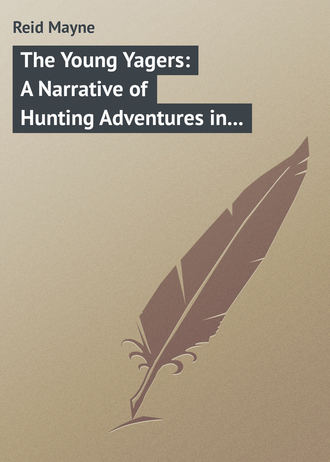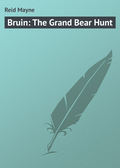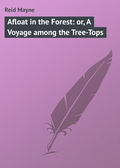
Майн Рид
The Young Yagers: A Narrative of Hunting Adventures in Southern Africa
Chapter Forty Four.
“Widow-Birds.”
They were only too glad to get off out of that neighbourhood, and at an early hour they inspanned and treked up the banks of the stream.
Just as on the other side, the road led through a succession of valleys, with groves of trees scattered over their surface; and as they proceeded, the mountain-spurs more frequently approached the banks, and at one or two places they found great difficulty in getting the wagons across the ridges. One of these was so steep, that for a while the travellers feared they would not be able to follow the stream any farther. The oxen refused to trek up the declivity, and neither whip nor jambok would force them forward.
But Congo knew of a plan by which they were at length induced to proceed; and both wagons arrived in safety at the top of the pass – not, however, until Swartboy had clicked and shouted, and Congo had screamed, till their throats were sore, and both had worn the voorslays of springbok skin from their long whips.
Congo’s mode of making the oxen move forward was a very simple one; and consisted in his going ahead of them and smearing the rocks along the path with the “mest” of the oxen themselves – thus leading the animals to believe that other oxen had gone before them, and that therefore the passage must be practicable, since some of their own kind had already made it! This mode is often adopted by the trek-boors of Southern Africa, when they wish to drive up very precipitous places, where the oxen are afraid to go of themselves.
The valley, which was reached after climbing through this difficult pass, was one of very small extent – not exceeding a couple of acres; and as the river had now become diminished to a mountain-stream, it was fordable at any point throughout the whole length of the little meadow in which the travellers encamped. At the head of this valley a ridge trended across the course of the stream through which the current had cleft a wide way; and the only road leading out above was along the channel of the river itself. Fortunately, this channel was nearly dry, else they could have gone no farther in that direction. As it was, the pebbly bed of the stream could be traversed by wagons, and they would easily get through to wider plains that stretched beyond. They had halted for the night in this little valley, because there was excellent grass for their cattle; and as wood grew along the sides of the rocky hills, and clear cool water ran down the stream, they possessed all the three necessary requisites for a traveller’s camp.
It was a curious little place where they had outspanned. As already stated, the level ground was not over a couple of acres in extent, though it was nearly of circular form. Through the very centre of it passed the stream, its bed being only a few feet below the general surface; and all around were the mountains, their precipitous sides rising like rocky walls to a height of several hundred feet, and completely enclosing the mountain within their embrace.
There were no trees upon the surface of the meadow itself, but against the rocks grew many kinds; some of them hanging with their tops downward, and some stretching horizontally outwards. A few small shrubs alone, with some reeds, grew upon the edge of the stream; but these were low, and would not have concealed a man standing erect.
In the centre of this natural amphitheatre the camp was formed – that is, the wagons were placed there. The horses and oxen were not fastened in any way, as it was supposed they would not care to stray out of the valley.
There were three good reasons why they should not wander. First, because they were wearied with a long day’s work, and one that had been particularly severe. Secondly, the paths leading out were difficult to find. And thirdly, because both the grass and water there were of as good a quality as either horse or ox could have expected to meet with elsewhere. There was no reason, therefore, why any of them should go beyond the confines of the valley where the camp was situated.
As usual, no sooner were Klaas and Jan fairly out of their saddles than they went bird’s-nesting. Several kinds of birds had been seen by them as they entered this secluded valley; and it was likely that some of their nests would be found at no great distance off.
And some were found. Upon the shrubs and reeds quite a colony of birds had made their habitations. They were small sparrow-looking birds, having nests of a kidney-shape, hollow in the inside, which was reached by little circular entrances, something like the nests of the common wren. The outside part was constructed of grass; while inside, the nests were lined with a soft substance resembling wool. This was the cottony down obtained from some plant that, no doubt, grew in that neighbourhood, but which the boys could not see anywhere around.
Now these little birds were already well known to the young yägers. They had met with them before; and all of them knew they were birds of the genus Ploceinae, or weaver-birds. They knew, moreover, that there are not only many species of weaver-birds, but that there are also many genera, or rather subgenera, of them, differing from each other in size, colour, and habits, but all possessing the curious instinct of building nests of a very ingenious kind – in other words “weaving” them; from which circumstance they derive their trivial name. The nests of all the species differ from each other. Some are constructed of a globe-shape; others like a chemist’s retort; others of kidney-form; and still another kind of nest is that of the “social weaver-birds.” These last unite in large numbers, and fill one great nest, or “hive,” which often fills the whole top of a great acacia, looking like a haystack built among the branches of the tree.
The little weavers observed by Klaas and Jan were of the genus Amadina– the Amadina squamifrons; and both the boys were glad at encountering some of their nests at that moment. Not that they were at all curious to see the eggs, for they had examined them often before. No: that was not the reason. There was another and a different one. It was this: the inside lining of the nest of the amadina makes excellent wadding for shot-guns – quite equal to tow, and even better than the softest paper; and as both Klaas and Jan were out of wadding, they expected to replenish their stock by robbing the poor amadinas of their pretty nests.
They would not have done so wantonly, for Hans would not have permitted them; but, as hunters, they stood in real need of the article, and therefore they took it without remorse.
Simple as the thing was, they were compelled to unravel the nests before they could get at the soft material with which they were lined: and this unravelling was not done without some difficulty, for the outside work was woven together like the rods in a fine piece of basket-work. The entrance which the bird had left for its own passage in and out was so small, that the boys could not thrust their hands into it; and, what was singular, this entrance, whenever the bird was absent from the nest, was so closed up that it was difficult to find it!
Having obtained as much wadding as they required out of a pair of nests, the boys did not disturb any of the others; but permitting them to hang where they had found them, returned to the wagons.
They had not been long there before their attention was attracted to another bird, and one of a rarer and more curious kind than the amadina. It did not differ much from the latter in point of size, but in the nature and colour of its plumage – which was most curious indeed. The bird which now occupied the attention, not only of Klaas and Jan, but of all the others, was about the size of a canary-bird; but its long tail-feathers, several times the length of its body, gave it the appearance of being much larger than it really was.
Its colour was of a very dark glossy brown, or nearly black, upon the head and over the upper parts of the body. Around the neck was a collar of orange rufous, which grew paler upon the breast, ending in a buff tinge over the abdomen, lower parts of the body, and thighs.
But it was in the tail-feathers that the peculiarity of this bird appeared. Of these, two were immensely long, set vertically, or “edgeways,” and curving far outward and downward. Two others, much shorter, also stood out edgeways above the first. These were broadly webbed at their bases, being at their widest rail three inches across; while their tips, for the length of three inches more, were entirely without any feathery web, and looked like a pair of stiff hairy spines projecting outward. Besides these two pairs of vertical feathers, there were four others on each side of the tail, nicely graduated one above the other, each being about a quarter of an inch shorter than the one immediately below it. All these tail-feathers were black.
But one of these birds was seen by the boys at their camp; but they noticed that it was accompanied by another bird of a rusty brown and whitish colour, and with a tail of the ordinary kind. This companion was neither more nor less than the female; while the gaudy creature with the orange colour and long tail-plumes was the male.
Hans’s knowledge was now brought into requisition, for the others had never seen this curious bird, and knew not to what species it belonged. Hans told them it also was one of the weaver-birds; known among naturalists by the name Vidua; among the French as “La veuve;” and among the English as “Widow-bird.” All of the party regarded this as a very singular name for the bird; and at once called upon the naturalist for an explanation of it. Fortunately, Hans was able to give them this; and that was more than the learned Brisson – he who baptised it Vidua and La veuve– has been able to do.
“Brisson,” said Hans, “has named the little creature ‘widow-bird,’ because he had heard that it was so called among the Portuguese; and the French naturalist assigns as a reason that it was so called on account of its colour and long tail! Such writers as Monsieur Brisson and Monsieur Buffon are never at a loss for reasons. Now it so happens that neither its colour nor tail had any thing to do with the origin of its name ‘widow-bird,’ which of itself is quite a misnomer. The Portuguese, who first drew attention to this bird, called it ‘Whidah’ bird, from the fact that it was received by them from the kingdom of Whidah in Western Africa. That is the way in which the bird has received its appellation.”
The Whidah-bird, on account of its livery habits, but more from the singularity of its tail-plumes, is a great favourite as a pet: and is often seen in cages, where it hops from perch to perch without fear of constraint, and alternately depresses and elevates its long tail with great vivacity. It is usually fed upon grain and several kinds of herbs, and is exceedingly fond of bathing itself in water. It moults twice a year; and during one period the male loses the long plumes which distinguish him from his mate, and altogether becomes so changed in colour, that the sexes are not then very easily told apart. It is only during the breeding season that the cock Whidah-bird attains his fine tail, and the orange and black colours of his plumage.
There are two species of Whidah-birds known to naturalists. The “Paradise widow-bird” (Vidua paradisea) is the one described above; and another which is called the “Red-billed widow-bird,” (Vidua erythrorhynca). The latter is a smaller species, and differs from the other in the arrangement of the tail-feathers. Its bill is of a deep red colour – whence the trivial name; and its plumage is of a bluish-black upon the upper parts of the body, with a white collar around the neck, white wing coverts, and whitish underneath.
Its habits, however, are precisely similar to those of the species Paradisea; and both are found inhabiting the same countries, viz: Western Africa. The range of neither reaches as far southward as the Cape Colony, but one of the species extends to the countries northward of the great Orange River, and is occasionally, though rarely, seen.
On account of its rarity in these parts, the young yägers, and particularly the naturalist Hans, were desirous of obtaining its skin; and for this purpose the shot-guns were levelled, and both the “widows” were ruthlessly brought down from their perch.
Chapter Forty Five.
The Pique-Boeufs
Of course Hans, aided by the others, immediately set about skinning the widow-birds, with an eye to their being preserved. Arend was his principal assistant, for Arend was clever with his hands; and was, moreover, as good a taxidermist as Hans himself. It never troubled Arend to know the genus or species of a bird; but give him the bird itself, and he could strip off its skin and mount it without leaving a trace of a ruffled feather.
While thus engaged, a noise fell upon the ears of the young yägers that caused all of them to start – Hans and Arend dropping the skins of the widow-birds, upon which they had been operating.
The noise which produced this startling effect, was neither more nor less than the cry of a bird, and but a small bird at that. The note very much resembled the well-known call of the mistle-thrush or screech-cock, (Turdus viscivorus). It was no louder, and the bird that uttered it was no bigger than this thrush; but for all that, the note produced a somewhat terrifying effect upon the yäger camp. All of the party, both yägers and attendants, knew the cry well. Even the buck-dogs sprang to their feet, and howled as it reached their ears; and the whole camp was suddenly in a commotion.
Now, my young reader, you will wonder why the cry of a bird, not bigger than a blackbird, could create terror in the minds of such courageous boys as our yägers; and you will naturally desire to know what sort of bird this was.
I have said the boys all knew it, the attendants and the dogs. Nay, more, the horses and oxen recognised that cry; and its effect on them was not less wonderful; for the moment it was heard, the horses tossed up their heads, snorted as if in terror, and commenced stampeding over the ground. The oxen exhibited similar symptoms of affright. Yes, horses, oxen, dogs, Kaffir, Bushman, and yägers, were all affected by the screech of that bird, as it pealed along the rocks, and echoed through the glen. All recognised in it the warning cry of the Pique-Boeuf!
An account of this singular bird will explain the cause of the consternation which its note had thus suddenly produced.
The “Pique-Boeuf” is about the size of a starling, of a greyish colour over the body, with short wings, and tail somewhat of a darker hue. Its feet are formed for grasping, and its claws are hooked and compressed. The most remarkable part of the bird is its bill. This is of a quadrangular shape, the lower mandible much stronger than the upper one, and both swelling towards the tip, so as to resemble a forceps or pincers. The purpose of this formation will be seen, when we come to speak of the habits of the bird.
These are, indeed, peculiar; and, by the laws of ornithology, stamp the Pique-Boeufs as a distinct genus of birds.
A celebrated French ornithologist, and a true field naturalist as well – Le Vaillant – thus describes the habits of these birds: —
“The bill of the Pique-Boeuf is fashioned as a pair of solid pincers, to facilitate the raising out of the hides of quadrupeds the larvae of the gadflies, which are there deposited and nourished. The species, therefore, anxiously seek out the herds of oxen, of buffaloes, of antelopes – of all the quadrupeds, in short, upon which these gadflies deposit their eggs. It is while steadied, by a strong gripe of the claws in the tough and hairy hide of these animals, that, with strong blows of the bill and powerful squeezes of the skin, at the place where the bird perceives an elevation, which indicates the presence of a maggot, he extracts it with effect. The animals, accustomed to the treatment, bear with the birds complacently, and apparently perceive the service which they render them, in freeing them from these true parasites, which live at the expense of their proper substance.”
Now, there are many species of birds, as well as the Pique-Boeufs, that lead a very similar life, living principally upon the parasite insects that infest the bodies of the larger quadrupeds, both wild and tame. In America, the “cow-bunting” (Icterus pecoris) is so termed from its habit of feeding upon the parasite insects of cattle; and among other animals it is a constant attendant upon the immense herds of buffaloes that roam over the great American prairies. Other species of icterus also frequent the vast cattle-herds of the South American plains.
The red-billed weaver-bird (Textor erythrorhynchus) is equally the companion of the African buffalo; and any one who has visited an extensive sheep-pasture cannot fail to have observed the common starling perched upon the woolly backs of the sheep. The white-necked crow (Corvus albicollis) is noted for similar practices, as well as several other species of Corvidae and Sturnidae. All of these kinds, however – the white-necked crow excepted – content themselves with only taking away the parasites, which are attached to the skins of the animals, or such as live among the hair and wool – none of the aforesaid birds having in their bills the necessary strength for extracting the maggots which are lodged beneath. Now, with the Pique-Boeufs, there is no difficulty about this. Their peculiar beaks enable them to penetrate the toughest hides of the large quadrupeds; and although they also feed upon the ticks and other parasites that rest upon the surface, they prefer the larvae that lie beneath. Hence, these birds are entitled to be regarded as distinct from any of the others; and naturalists have formed them into a separate genus – the genus Buphaga, or “beef-eaters.”
It is scarcely necessary to point out the absurdity of this name, which seems to have been given from a misapprehension of the habits of the birds. The Pique-Boeuf is no beef-eater, but a “beef-picker,” if you will, as the French phrase very properly expresses it. But M. Brisson, who gave the name, seems very much to have resembled his more celebrated countryman – the great closet naturalist, Buffon – in ascribing such habit to birds and animals as suited his fancy.
Buphaga is the name given, and so let it stand.
Only two species have been yet observed. One is the Buphaga erythrorhyncha, or red-billed beef-eater – so called from the colour of its beak, which is a beautiful coral-red – while the more common species already described has a yellow beak. The latter is the Buphaga Africana. Both species are birds of Africa – the “coral bill” (Bec corail) being also a native of the island of Madagascar. The “coral bill” is smaller than the Buphaga Africana, and somewhat different from it in colour. The tint of its plumage is more sombre. The upper parts, head and throat, are of an ash-brown, glazed, as it were, with bluish; and beneath, the bird is of a yellowish rust colour. Its bill, also, is smaller and less powerful than that of its congener.
The Pique-Boeufs are generally seen in company; but they never fly in large flocks. Six or eight of them may usually be observed together. They are very wild shy birds, and it is difficult to approach within shooting distance of them.
The only chance of getting near enough is to approach behind the body of an ox, or some other animal – using the latter as a stalking-horse, and driving it gently towards those beasts on whose back the birds may be perched. The gunner, by then showing himself suddenly, may obtain a shot at them on the wing.
Such are the habits of the Pique-Boeufs. But all this does not explain why it was that the screech of one of these birds had thrown the camp of the young yägers into such a state of excitement or alarm. The reason remains to be told. It was this: —
Of all the quadrupeds to which the Pique-Boeufs attach themselves, there are none upon which they are such constant attendants as the rhinoceros. This animal is the victim of many parasitical insects – of ticks and larvae. His huge body and corrugated skin, of such vast extent, offer an ample field for such creatures, and consequently afford a supply of food to the Pique-Boeuf, which is unfailing.
The rhinoceroses, therefore, of all the four species that inhabit South Africa, are always attended by the beef-eaters, which, on this account, are known among hunters as “rhinoceros-birds.” Go where the rhinoceros will, the Pique-Boeufs follow him, perching upon his back, his head, or any other part of his body, and remaining there quite unconcernedly, as if they regarded that situation as their natural roosting-place and home. The rhinoceros himself never dreams of molesting them. On the contrary, he finds their presence extremely useful to him. Not only do they give him ease, by destroying the insects that would otherwise annoy him, but in another sense they do him an essential service. They warn him of the approach of the hunter, or any other danger. The moment such appears, the rhinoceros, who himself may have been asleep, is instantly aroused by the harsh screeching of the birds, and put upon his guard. Should their voices fail to awake him, these cunning sentinels will flutter around his head, and peck into his ears until they succeed in giving the alarm. With elephants and hippopotami they act in a similar manner; so that one of the difficulties to be encountered by the hunter in pursuit of these animals, is the vigilance of the little winged sentinel that thus keeps watch over their sleep!
It was this curious habit, then – well known to every creature in the camp – that caused all hands to start up on hearing the screech of the Pique-Boeuf. The presence of the bird announced the proximity of the dangerous “rhinoster.”







